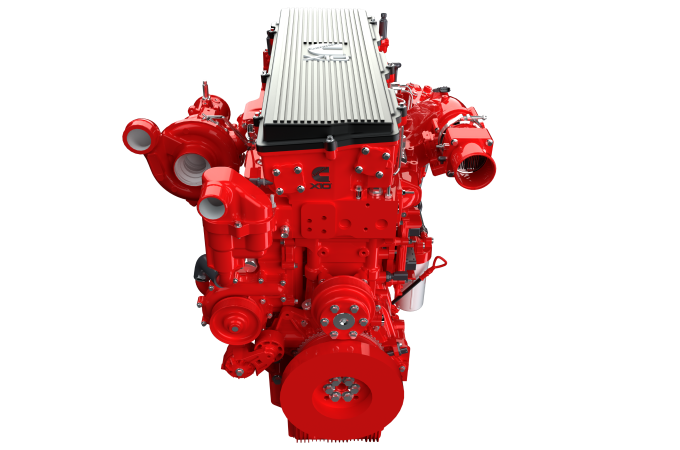Road Transport Expo 2025: Cummins updates T&BB on Euro 7 and alternatives to diesel
By Bradley Osborne - 12th August 2025

The X10, Cummins' 'Euro 7-ready' engine
UK – Although it is today a manufacturer of various electric products – including e-powertrains, battery packs, and electrolysers – American engine manufacturer Cummins Inc is also concerned about regulation that focuses only on tailpipe emissions rather than a holistic well-to-wheels approach. In a previous conversation with Truck & Bus Builder, Bill Lamb, director of Cummins’ engine business platform strategy, noted that, with the current rate of battery-electric truck adoption, commercial vehicle manufacturers will find it extremely challenging to meet future CO2 emissions reduction targets without the help of two alternatives to pure electric: hybrid and biofuels. We met again at the recent Road Transport Expo, held between 24-26 June at NAEC Stoneleigh, to discuss not only alternatives to electric but also Cummins’ progress towards Euro 7.
During our conversation at the show, Lamb reiterated Cummins’ support for low-carbon fuels such as hydrotreated vegetable oil and ‘B100’, which are already in use on European roads. Their impact on fleet emissions, however, is currently unrecognised by regulation that focuses on the “tank-to-wheel” rather than the “well-to-wheel” (i.e., looking only at vehicle emissions and not at emissions generated and/or saved from source to use). In his previous interview with T&BB, Lamb admitted that measuring the use of alternative fuels is challenging: once a truck engine is out on the road, Cummins does not know whether it is running on diesel, biofuels, or some combination of the two. However, on this occasion, Lamb said that the technology for tracking fuel production and use in real time is now under development. In any case, Lamb believes that a fairly accurate picture of biofuel use can be built up simply by finding out how much is being supplied to stations across Europe. However one measures their use, “there needs to be regulatory recognition of alternative fuels actually being used on the road,” Lamb told T&BB.
Given the current trajectory of the commercial vehicle market, there is no way that manufacturers will be able to achieve the 43% carbon reduction target in 2030 with electric vehicles alone. It remains the view of Cummins that all technologies be treated as viable solutions to the problem of decarbonisation; however, this is challenging when regulators continue to focus solely on tailpipe emissions, potentially overlooking the near-term benefits of biofuels and hybrids.
As far as Euro 7 goes, Lamb told T&BB that the regulators have made their intentions clear: “we’re pretty confident that it will go ahead as planned,” he said. While the specific details of the regulation have yet to be decided, Cummins has enough information already to begin developing its answer to Euro 7. There are question marks, however, around whether other legislations will follow suit. For example, what will Britain do, now that it is no longer subject to EU regulation? Cummins would welcome Britain adopting a similar emissions regime: “we want clear and common regulations [across Europe]”, Lamb said. He added that South Korea and Japan are likely to follow Euro 7, whereas India and China may adopt slightly different standards. These other countries are expected to enforce their new emissions standards by 2030.
Cummins’ work on Euro 7
Cummins is busily “getting on with Euro 7”, Lamb told T&BB at the Road Transport Expo. The company spent the last two to three years on “pre-programme development”; that is to say, trialling several different options and deciding which path to take. In the last twelve months, Cummins’ development approach to Euro 7 was “solidified”, according to Lamb. The company is now embarking on a three-year “series development” timeline, looking towards a production launch ahead of the May 2029 full implementation date for all new commercial vehicles.
The emissions architecture and aftertreatment system of Cummins’ Euro 7 engines will, of course, be very different from Euro VI, but Lamb told T&BB that the engine itself will not need to change very much in order to comply with the new regulation: “this is not as big a step as Euro V to VI was,” he said. Cummins’ Euro 7 engines will be based on the HELM (“Higher Efficiency, Lower emissions, and Multiple fuels”) engine platform first introduced at the IAA in 2024. Development of the new emissions architecture has been aided by the use of software programmes that were not available for Euro VI, such as the latest finite element analysis tools for simulating the behaviour of the engine. Cummins is also employing simulations in the design of its aftertreatment system, which is becoming ever more sophisticated.
The proposed Euro 7 legislation imposes certain new requirements on engine manufacturers. One of these is a provision that engines comply with the standards for a longer span: up to 875,000 kilometres and/or up to fifteen years. Another new feature of the legislation is onboard monitoring, in addition to the onboard diagnostics introduced during Euro V. Whereas onboard diagnostics looks at each subsystem in the emissions architecture for faults, onboard monitoring will examine the system as a whole for faults that could lead to non-compliance with the regulation. A multitude of minor failures in the whole system which would have been missed previously will now be picked up, thus “closing the gaps” in the onboard monitoring of emissions compliance, Lamb told T&BB. The system will employ sensors that continuously measure tailpipe emissions and communicate the data to the cloud. The challenge now is to ensure that sensors have “enough fidelity to get the accuracy and durability required to do the job,” Lamb said.

Bill Lamb joined Cummins in 2006 as a technical specialist in its combustion, performance & emissions team in Darlington. Since then, he has been promoted to various management positions, including head of product planning for Europe between 2019 and 2023. In his current role, Lamb sets the overall platform strategy for Cummins’ engine business globally.


